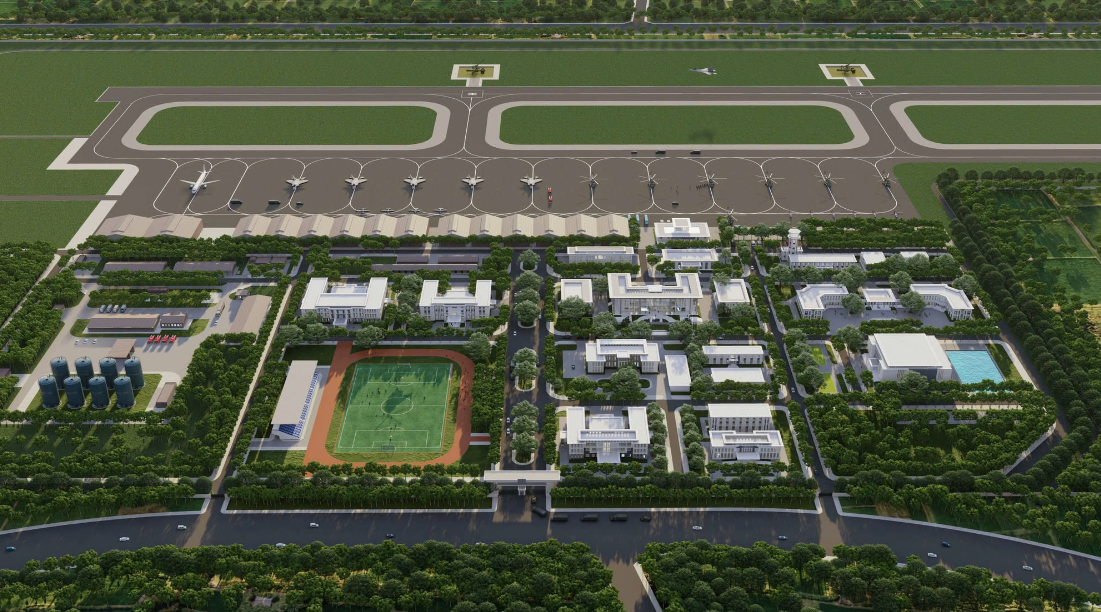Gia Binh – A New International Airport 60km from Noi Bai Airport
After being incorporated into the national airport network development plan, the Ministry of Transport has officially approved the master plan for Gia Binh International Airport for the period 2021–2030, with a long-term vision extending to 2050.
Under this plan, by 2030, the airport will be developed into an international hub meeting ICAO 4E standards, with an annual capacity of approximately 1 million passengers and 250,000 tons of cargo. By 2050, its capacity is projected to reach 3 million passengers and 1 million tons of cargo per year.
Gia Binh International Airport will feature two terminals: a VIP terminal dedicated to private and government aircraft, located to the south of the specialized aircraft apron, covering around 3.2 hectares; and a main passenger terminal designed for both commercial and general aviation, situated southwest of the VIP terminal.

The airport will feature a single runway measuring 3,500 meters in length and 45 meters in width, capable of accommodating major aircraft models such as the Boeing 777, Boeing 787, Airbus A350, A321, as well as private jets and specialized aircraft.
A total of 26 aircraft parking stands are planned for the airport, with 11 stands scheduled for construction by 2030. The air traffic control tower will be strategically located northeast of the passenger terminal, occupying an area of approximately 1.33 hectares.
The airport will be equipped with state-of-the-art systems, including advanced runway lighting, modern navigation aids, weather radar systems, an Automated Weather Observing System (AWOS), and other critical infrastructure to ensure safe and efficient flight operations.
Once fully developed, the airport will cover a total area of approximately 363.5 hectares. To support seamless logistics and operations, the Ministry of Transport has also integrated four new inland container depots (ICDs) connected to Gia Binh Airport into the national development plan. These facilities are expected to enhance cargo handling capacity and strengthen the region’s transportation network.
The planned capacity of Gia Binh Airport is projected to handle 1 to 3 million passengers per year, with provisions for future expansion to accommodate up to 5 million passengers annually.
For cargo operations, the airport is expected to handle between 250,000 to 1 million tons of goods per year, with potential expansion capabilities to support a capacity of 1.5 to 2 million tons annually.
These inland container depots (ICDs) include:
- Tan Chi ICD in Tien Du District, Bac Ninh Province
- Que Vo ICD in Que Vo District, Bac Ninh Province
- Yen Phong ICD in Yen Phong District, Bac Ninh Province
- Gia Binh ICD in Gia Binh District, Bac Ninh Province
These ICDs will have a clearance capacity ranging from 70,000 to 200,000 TEUs (20-foot containers) per year, with planned areas varying between 7 to 52 hectares, depending on each development phase.
With this scale, Gia Binh International Airport is expected to become one of the largest airports in northern Vietnam and across the entire country, playing a pivotal role in boosting regional connectivity and economic growth.
Connecting Gia Binh Airport with Hanoi to Ease Pressure on Noi Bai Airport
The development of Gia Binh International Airport aims to create a direct and efficient connection with Hanoi, reducing congestion and operational pressure on Noi Bai International Airport. This new airport will help distribute air traffic more evenly across the northern region, accommodating the growing demand for both passenger and cargo transportation.
By establishing a fast and direct route between Gia Binh Airport and Hanoi’s city center, the project will enhance regional connectivity, promote economic growth, and support the development of a comprehensive logistics network. This strategic connection is expected to ease the burden on Noi Bai Airport, which has been operating near or above capacity in recent years.
At the request of Prime Minister Phạm Minh Chính, relevant agencies are tasked with studying the route, proposing solutions, and constructing the fastest and most direct road connecting Gia Binh Airport to Hanoi within a maximum timeframe of two years.
On the evening of February 23, Prime Minister Phạm Minh Chính chaired a meeting with ministries, sectors, and local authorities to discuss the progress of Phase 1 implementation, explore plans for Phase 2 of the Gia Binh Airport project (Bắc Ninh), develop a connecting road between the airport and central Hanoi, and establish a logistics hub at the airport.
Previously, during the groundbreaking ceremony for Phase 1 of the airport in December 2024, the Prime Minister instructed relevant agencies to research and implement a plan for the road connection between Gia Binh Airport and the capital. The plan is expected to be finalized by June 2025 at the latest.

Prime Minister Urges Rapid and Efficient Connection Between Gia Binh Airport and Hanoi
Prime Minister Phạm Minh Chính has emphasized the need to study and implement the fastest, most direct, visually appealing, and efficient route connecting Gia Binh International Airport to Hanoi’s city center. The project must be completed within two years at most.
The Prime Minister highlighted the significance of this infrastructure not only as a transportation link but also as a symbol to promote Vietnam’s image to international partners, attract investment, and boost tourism.
In addition, he directed the development of a modern, smart logistics hub at the airport, with a focus on supporting e-commerce growth. The Prime Minister underscored the urgency of completing these projects swiftly, effectively, and on schedule, while also proposing special mechanisms to facilitate their implementation.
The overarching principle is clear: speed, quality, safety, and environmental sustainability must all be ensured throughout the process.










